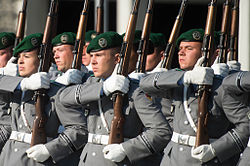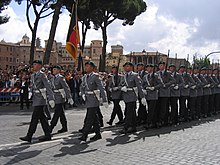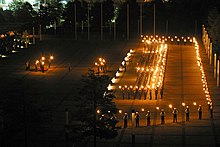
The Karabiner 98 kurz, often abbreviated Karabiner 98k, Kar98k or K98k and also sometimes incorrectly referred to as a K98, is a bolt-action rifle chambered for the 7.92×57mm Mauser cartridge. It was adopted on 21 June 1935 as the standard service rifle by the German Wehrmacht. It was one of the final developments in the long line of Mauser military rifles.

Jäger is a German military term referring to specific light infantry units.

The Bundeswehr is the armed forces of the Federal Republic of Germany. The Bundeswehr is divided into a military part and a civil part, the military part consisting of the German Army, the German Navy, the German Air Force, the Joint Support Service, the Joint Medical Service, and the Cyber and Information Domain Service.

The Federal Ministry of Defence, abbreviated BMVg, is a top-level federal agency, headed by the Federal Minister of Defence as a member of the Cabinet of Germany. The ministry is headquartered at the Hardthöhe district in Bonn and has a second office in the Bendlerblock building in Berlin, which is occasionally used colloquially to denote the entire Ministry.

The Großer Zapfenstreich is a military ceremony performed in Germany and Austria. It is similar to the military tattoo ceremony performed in English-speaking countries, and is the most important ceremonial act executed by the German federal armed forces, the Bundeswehr, and by the Austrian federal armed forces Bundesheer. The Zapfenstreich is performed only during national celebrations and solemn public commemorations, to honour distinguished persons present at such special events. Examples are the farewell ceremony for a German federal president, or at the conclusion of large military exercises. It takes place in the evening hours and consists of a military formation of at least one military band, two platoons of armed infantrymen, and two lines of soldiers carrying torches, in total about 400 men.

The Joint Support Service is a branch of the German Bundeswehr established in October 2000 as a result of major reforms of the Bundeswehr. It handles various logistic and organisational tasks of the Bundeswehr. The SKB is one of six components of the Bundeswehr, the other five being the Army, Navy, Air Force, the Joint Medical Service, and the Cyber and Information Domain Service. As of April 2020, the force is composed of 27,840 personnel. In May 2021 the minister of defense Annegret Kramp-Karrenbauer together with inspector general Eberhard Zorn published a plan to dissolve the Joint Support Service and to reintegrate its units into the army, navy, airforce and cyber command.
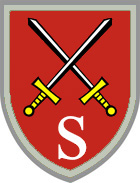
The German Army Aviation Corps is a special unit within the German Armed Forces (Bundeswehr). The German Army Aviation Corps is a branch of the German Army (Heer), containing all its helicopter units. The German Air Force and the German Navy both also have their own helicopter units.

The Feldgendarmerie were a type of military police units of the armies of the Kingdom of Saxony, the German Empire and Nazi Germany until the conclusion of World War II in Europe.
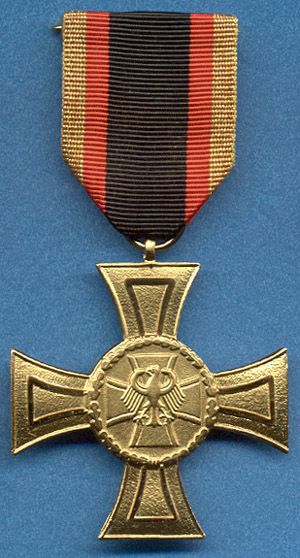
The Decorations of Honour of the Bundeswehr are a series of military decorations of the Bundeswehr, the armed forces of the Federal Republic of Germany. These honours and awards were introduced in 1980 on the occasion of the 25th anniversary of the Bundeswehr by then Minister of Defence Hans Apel and subsequently approved by President of the Federal Republic Karl Carstens.
The red beret is a military beret worn by many military police, paramilitary, commando, and police forces and should not be confused with the maroon beret worn by airborne troops all around the world.

Rheine-Bentlage Air Base was an air base of the German Armed Forces and located near the village of Bentlage, 2 km northwest of the city of Rheine, North Rhine-Westphalia, Germany.

Infantry Regiment 9 of Potsdam was an infantry regiment in Weimar Republic's Reichswehr and Nazi Germany's Wehrmacht, descended from famed 1st Prussian Regiment of Foot Guards in the German Empire's Deutsches Reichsheer. Garrisoned at the cradle of Prussian army and rich with tradition, it was nicknamed 'Count Nine' or 'I.R. von 9' by its detractors because of high percentage of Prussian aristocrats and purported arrogance in its ranks.
Wolfram Kühn is a retired German Navy Vizeadmiral. He served as Deputy Inspector General of the Bundeswehr and Inspector of the Joint Support Service from 2006 to his retirement in 2012.

The 21st Panzer Brigade "Lipperland" is a brigade in the German Army and part of the Bundeswehr. The brigade staff and most of its units are based at the Field Marshal Rommel Barracks in Augustdorf, North Rhine-Westphalia. Several companies are based in Glückauf Barracks in Unna-Königsborn.
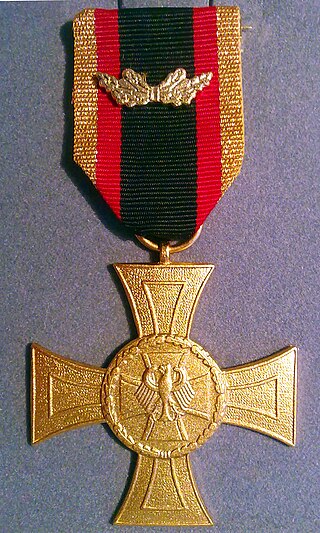
The Bundeswehr Cross of Honour for Valour is the highest military decoration of the Bundeswehr. It is the highest class of the Bundeswehr Cross of Honour. The decoration is the first combat valour award presented by Germany since World War II.

The Air Force Forces Command, previously the Air Fleet Command from 1970 to 2001, was a high command authority of the German Air Force of the Bundeswehr, responsible for the operations of the Air Force. In 2013, it was disbanded after its functions were merged into the new Air Force Command, along with those of the other high command bodies of the German Air Force.

The Staff Band of the Bundeswehr is the main representative brass band of the Bundeswehr, stationed in Berlin. It works together with the Wachbataillon in the Berlin Garrison Command, having responsibility for protocol during state receptions of the Federal President, Chancellor and the Minister of Defense. The band is responsible for performing pieces such as the anthems of foreign countries as well as the Preussischer Präsentiermarsch during arrival honors ceremonies for visits by foreign leaders to Germany. It is among 6 other German military bands that fall under the command of the Joint Support Service.
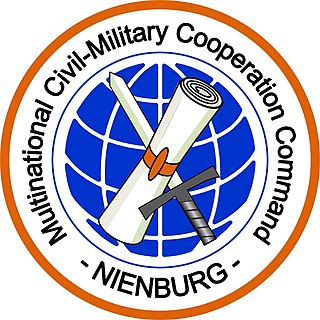
The Multinational CIMIC Command, is the fourth generation of Civil-military co-operation of the Bundeswehr. The first predecessor was already formed in 2001 out of parts of the German Army (Heer), the German Air Force (Luftwaffe) and the German Navy (Deutsche Marine) as part of the Joint Support Service (Streitkräftebasis) at the Clausewitz-Barracks in Nienburg, Lower Saxony. In 2017 it employs around 200 soldiers and Civil Servants Additional to this the centre receives support by the local state commands (Landeskommando) of the States of Germany (Bundesländer) and the academy of the Federal Office for Civil Protection and Disaster Assistance in Bad Neuenahr.

The Kommando Territoriale Aufgaben der Bundeswehr short (KdoTerrAufgBw) "Bundeswehr Territorial Tasks Command" of the Bundeswehr is based in the Julius-Leber- Kaserne (Barracks) in Berlin-Wedding was founded in 2013 and is in charge of all territorial tasks of the forces as well as for the support of the civil administration.

The Gardebataillon is a ceremonial unit in the Austrian Armed Forces. The Gardebataillon is one of the most important military units in the Austrian Armed Forces as its main task is to represent Austria at home and abroad. It is stationed exclusively at Maria Theresien Barracks in Vienna.
